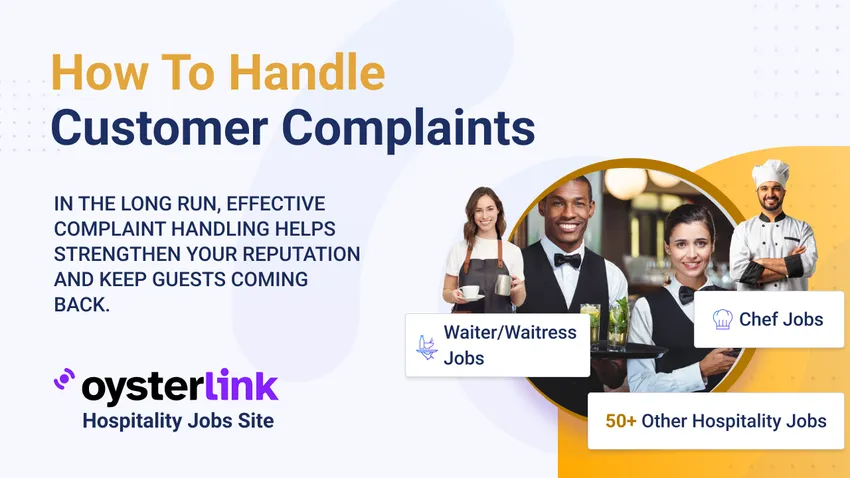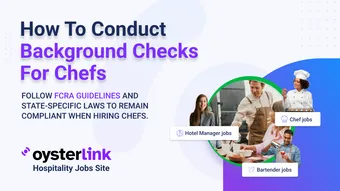Complaints are inevitable in the restaurant industry. While such situations may feel stressful at the moment, they also provide an opportunity to show professionalism, empathy and problem-solving skills.
In fact, studies show that 96% of customers leave a business after poor service, but a well-handled complaint can turn them into loyal advocates.
Read on for tips to handle customer complaints confidently and turn challenges into opportunities to improve service and guest satisfaction.
Why Handling Customer Complaints the Right Way Matters
Handling customer complaints shows guests that their experience matters.
When your team responds quickly, listens carefully and finds a fair solution, it sends a strong message that the restaurant values its customers.
A thoughtful response can turn a frustrating moment into a positive impression — and sometimes even a loyal relationship.
Guests who feel respected and heard are far more likely to return, recommend your restaurant, and share good reviews.
Consistent, professional complaint management also builds stronger teamwork among staff, boosts confidence and reinforces a culture of service excellence.
In the long run, effective complaint handling helps strengthen your reputation and keep guests coming back.
Common Restaurant Complaints + Sample Responses
Figuring out how to handle customer complaints in a restaurant requires understanding the specific nature of each issue and addressing it appropriately.
Here are some common issues guests may bring up, along with suggested scripts to help you respond effectively.
Slow service
Guests often complain about long wait times — whether it’s for seating, food or drinks — which can make them feel like they’re not being prioritized.
Example script: “I understand your time is valuable, and I apologize for the delay. Let me expedite your order right away. Thank you for your patience.”
Rude or unprofessional staff
Customers may feel upset if they perceive the staff as rude, dismissive or inattentive, which can negatively affect their dining experience.
Example script: “I sincerely apologize for any disrespect you've experienced. We truly value your feedback, and I’ll make sure to address this with my manager. Please allow us to ensure your complete satisfaction from this point forward.”
Incorrect orders
Receiving the wrong dish or having an item missing from the order is likely to leave a customer feeling disappointed.
Example script: “I’m so sorry about the mix-up. Let me correct this immediately and have your correct order prepared as quickly as possible.”

Food quality issues
These typically include concerns about the taste, temperature, freshness or presentation of a dish.
Example script: “I’m very sorry that the dish didn’t meet your expectations. Would you like us to remake it, or is there something else on the menu I can bring for you?”
Cleanliness issues
Guests may raise concerns about dirty tables, unclean restrooms or other hygiene-related problems, which can harm their perception of the restaurant.
Example script: “I’m sorry that the cleanliness wasn’t up to standard. I’ll address this right away and ensure everything is cleaned according to our usual standards. Thank you for bringing it to our attention.”
Noise levels
Excessive noise from loud music, other patrons or poor acoustics can make guests uncomfortable or disrupt their dining experience.
Example script: “I understand the noise level might be uncomfortable. Let me adjust the volume, or if you’d like, I can see if there’s a quieter area available for you.”
Billing errors or pricing concerns
Mistakes on a bill, such as overcharges or incorrect items, can frustrate guests and make them question the restaurant’s attention to detail.
Example script: “I apologize for the mistake on your bill. Let me correct it right away and bring you an updated bill. Thank you for pointing this out.”
Mismanagement of reservations
This covers reservation mix-ups and lost reservations which can lead to frustration and inconvenience for guests.
Example script: “I’m so sorry about the confusion with your reservation, and I understand your frustration. Let me check all available options to accommodate you as quickly as possible.”
Long waits
Extended wait times for walk-ins or reservation holders can make guests feel undervalued.
Example script: “I understand the wait is longer than expected, and I sincerely apologize. I’ll keep you updated on your table’s status and ensure we get you seated as soon as possible.”
Tips for How To Handle Customer Complaints in a Restaurant
Now that we’ve covered the most common types of customer complaints, let’s look at some of the key tips for anticipating, addressing and even preventing these.
1. Recognize the Warning Signs Early
Preventing customer complaints starts with recognizing subtle signs of dissatisfaction before they escalate into voiced concerns.
Skilled restaurant Servers know that catching these warning signs early allows for proactive service adjustments.
Body language speaks volumes about guest satisfaction, so watch out for these telling signs:
- Crossed arms and leaning back from the table
- Frowning while examining the bill
- Shaking heads while eating
- Pushing plates to the center without finishing the food
- Avoiding eye contact during check-ins
Notably, customers who exhibit these cues need immediate attention.
Approach these tables with extra care and ask specific questions about their experience (e.g., "How is everything tasting?" instead of "Is everything okay?").
Remember that addressing concerns at this stage prevents small concerns from becoming formal complaints.
2. Control Your Emotional Response
Guest complaints reflect their experience, not your worth as a restaurant Server. To keep your composure, take a quick breath and count to three before responding to heated situations.
Treat challenging guests as opportunities to demonstrate your service skills.
Focus on solving specific issues rather than taking comments personally. The best response to a raised voice? Lower yours.
A calm approach helps you think clearly and find real solutions that work for your guests.

3. Maintain Proper Posture
Your body language tells guests how seriously you take their concerns. Stand straight with relaxed shoulders, keeping your stance open and attentive.
Avoid crossing your arms — it sends a defensive message to already frustrated guests.
Make natural eye contact without staring. Keep about two feet between you and your guests, close enough to hear clearly while respecting personal space.
Also, position yourself slightly angled rather than straight-on. This subtle shift helps guests feel more comfortable during difficult conversations.
4. Keep Your Voice Steady
Speak clearly at a measured pace, especially when you have complaints to handle. These voice control techniques work well:
- Speak just below your guest's volume level.
- Keep your tone even and controlled.
- Maintain a steady, unhurried pace.
- Use strategic pauses for emphasis.
Make your voice warm and professional, even when guests are being rude. A steady voice shows confidence and skill, and guests will feel you're handling their concerns properly.
Remember — your tone matters more than your exact words when showing sincerity and respect.
See also: Key Insights for Overcoming Restaurant Challenges in 2025
5. Follow the LAST Method
The LAST Method stands for “Listen,” “Apologize,” “Solve” and “Thank.”
This four-step system helps Servers turn customer complaints into opportunities for exceptional service.
- Listen without interrupting: Give guests your full attention. Maintain eye contact, avoid defensive reactions, and let them share their full story.
- Apologize sincerely: Acknowledge their concern directly. Use their own words to show you understand — a genuine apology goes further than a generic “sorry.”
- Solve the problem quickly: Act right away and explain what you’re doing. Keep guests updated until the issue is fully resolved.
- Thank the guest: Show appreciation for their feedback. It helps improve service and prevents similar issues in the future.

6. Know When It’s Time To Call a Manager
As a Server, knowing when to escalate an issue helps maintain a smooth service flow.
Below are some scenarios in which you should promptly notify your Restaurant Manager:
- Foreign objects in food
- Disputes over billing amounts exceeding $50
- Multiple complaints from the same table
- Guest illness claims
- Situations involving potential liability issues
7. Ensure Clear Communication With Kitchen Staff
This is especially important in resolving food-related complaints.
Approach a Chef or the Kitchen Manager directly with specific details about the customer’s concern. Focus on what needs fixing rather than what went wrong.
For instance, saying “Table 12 needs their salmon cooked through” works better than “Table 12 is unhappy with their food.”
This approach helps the kitchen staff solve issues quickly without disrupting their workflow.
8. Coordinate With Fellow Servers for Support
Building strong work relationships with your fellow Servers creates a reliable support network.
Work out clear hand signals or code words for covering sections during complaint handling. For instance, a quick eye contact and nod might mean “Watch my tables for five minutes.”
Of course, make sure to help your coworkers when they handle complaints. That way, they'll return the favor when you need backup.
9. Document and Follow Up on Customer Complaints
Effective follow-up is essential to handling customer complaints and improving future service.
After addressing a guest’s concern, track the status of any promised actions or guest recovery efforts, such as comp cards or special requests for their next visit.
Keep detailed records of these interactions and update documentation after following up to confirm the guest’s satisfaction.
Share any unresolved issues or recurring patterns with management to help identify training needs or operational adjustments.
Regularly reviewing complaint records ensures ongoing improvements and demonstrates to customers that their feedback is taken seriously.
10. Recover and Reset Between Tables
Maintaining composure after handling difficult customer complaints requires strategic recovery techniques.
Skilled Servers understand the importance of resetting their mental state between tables to ensure consistent service quality.
Take brief moments between tables to straighten your uniform and check your appearance in designated staff areas.
Second, review your section layout and table status to maintain optimal timing for all guests.
You might also want to “reset” your facial expression before approaching new tables, ensuring previous interactions don't affect your current service.
Lastly, taking a moment to drink water helps clear your mind while staying hydrated during busy service periods.
When and How To Involve Managers and Other Staff
Some complaints are best handled as a team effort. Knowing when to involve a Manager, communicate with the kitchen or get help from another Server keeps service smooth and guests satisfied.
Bring in a Manager if the issue is serious — such as a billing error, food safety concern, or a guest who’s especially upset.
Managers can make quick decisions, offer compensation if needed and show guests that their feedback is being taken seriously.
When food or drink is involved, speak directly with the kitchen and share clear details about what needs fixing.
Avoid blame — focus on solutions that get the guest taken care of quickly.
And don’t hesitate to lean on your coworkers. A quick handoff or extra set of hands during a busy shift can make a big difference.
When everyone communicates and works together, even difficult situations can be handled calmly and professionally.
Conclusion
Understanding how to handle customer complaints in a restaurant can mean the difference between losing them and building lasting loyalty.
As a Server, each complaint presents a chance to showcase your professional skills and improve service quality.
Success starts with spotting warning signs early and maintaining composure under pressure. The LAST method provides a reliable framework, while proper documentation helps prevent recurring issues.
Take your service skills to the next level with OysterLink, the ultimate resource for hospitality professionals.
From job-related tools to advice from industry experts, OysterLink equips Servers and other restaurant staff to handle challenges with confidence and deliver exceptional dining experiences.
Lastly, if you’re thinking of taking your hospitality career to the next level, check out exciting job opportunities on OysterLink with the tool below!










Loading comments...